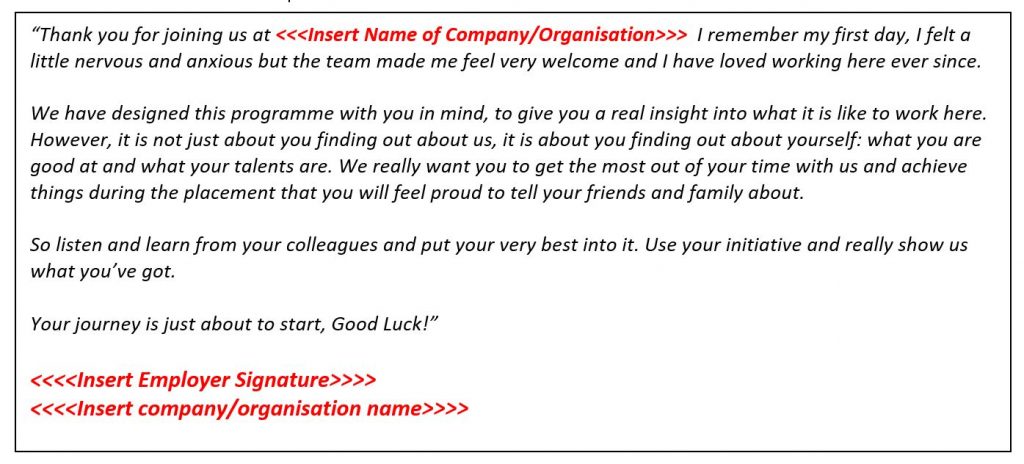
Employers’ guide to work experience
Introduction
Work experience plays a vital part in preparing young people for their future careers. It’s an opportunity for them to step outside the classroom and, for many, a chance to see the world of work for the very first time. It can build confidence and be the first thing to go on a CV.
Employers really can benefit from the exchange, as running effective work experience programmes can provide great opportunities for developing staff, engaging with new ideas and future customers – as well as providing a pipeline for future recruits.
When done well, work experience can have a really positive impact on all involved.
By working with a school, college or other provider your business will be able to explore ways to offer something really meaningful that meets your own needs.
There are two key stages during which students may look to you for work experience:
- Key stage 4 (aged 14-16)
- Key stage 5 (aged 16-19)
What should you do and offer?
Ask yourself the right questions as an employer and you’ll be well-placed to deliver top-quality work experience that will benefit not only young people in real need of your support but also you, your staff and your business.
Why do you want to offer work experience?
Your answer might be driven by Corporate Social Responsibility, responding to requests, future talent pipelines, or developing existing staff. Knowing why you want to offer work experience will help your organisation shape and tailor it to meet your goals and expectations.
Who will you offer it to? How many opportunities can you create?
Not all young people are the same, and some marginalised young people will be in desperate need of the glimpse of the working world you can offer. For example, your work experience opportunities could be offered to secondary schools, college or university students, or those young people not in education, employment or training.
What formats can you offer?
Work experience can come in numerous forms. Typical work experiences offered by employers tend to be:
- Work shadowing
- Work experience placement for 1 or 2 weeks
Is the experience for a specific role or more generally within the business?
Think about where the young person will work, and what you have the capacity to deliver.
Do you plan for work experience students to stay engaged with your business and potentially apply for future roles?
Consider how you may want to use work experience as a future recruitment tool.
Who needs to be involved in the process within the organisation?
Who is the lead contact? Do line managers need to be engaged and supported? Can someone act as a work experience buddy to help young people acclimatise to the working environment more smoothly during their experience?
How will you manage and support the student?
Research, document and action:
- Induction
- Clear tasks
- Links to learning outcomes
- Feedback
- References at the end of the experience
- Dealing with problems that may arise
Have you considered all the practicalities?
The following elements are vital to consider:
- Health and safety
- Risk assessments
- Insurance
Do you know what you have in place, and what a business of your size needs to have covered?
Checklist
| Role Description | Hours of work Uniform/dress code Breaks |
It is really important to set out key information, roles and expectations for the experience. | Think about using the Work Experience Workbook for the student and their line management. |
| Application & Interview Process | Advertisement Application Process Interview Questions and Process |
Consider how you want young people to apply.
|
What is the process to ensure inclusion and fairness? |
| Accessibility | Have you considered how you can make this work experience inclusive for young people with additional support needs? | Organisations should ensure the opportunities it provides can be accessed by young people with additional needs and that activities are tailored to meet the needs of individuals. |
Activities are tailored to meet the needs of individuals. |
| The experience | Work experience tasks Rotating around the business Learning outcomes |
The placement should include a range of experiences so that the participant can learn about the whole business as well as a specific job role. Having a work experience schedule can be really valuable. | Think about using the Work Experience Workbook for the student and their line management. |
| Managing & Mentoring | Induction Reflection Feedback References |
Work experience provides lots of learning opportunities. How will you capture them all? | Think about using the Work Experience Workbook for the student and their line management. |
| Legal | Employers Liability Insurance Risk Assessment Safeguarding DBS Checks are they needed? Hygiene & Health & Safety Keeping student records – GDPR Company Policy |
There are a number of checks you will need to make to ensure your business is ready for young people. They are not there to limit the experience. | You can find advice and information on the HSE and .Gov websites. Most businesses find meeting these checks straightforward. |
See also: Work Experience Employer Guide from Youth Employment UK
Work Experience Workbook – instructions for use
This is the main document that the student will keep with them and fill in each day. It helps them keep all the key details in one place.
You may also wish to look at the Youth Employment UK website for further guidance and ideas.
Please be aware that this is just guide and the Health and Safety aspects in particular must be carefully considered and edited to suit your business. Up to date HSE information for Work Experience placements can be found at www.hse.gov.uk
Before the placement:
Before the student comes to your place of work, it is good practice to send them a welcome message and also a little information about where they will be working and who they will meet.
Below is an example welcome message.
This and an ‘about us’ section can be sent to the student.
Welcome message
About us
Add some text about what your business/organisation is about to help the student understand what you do, how you do it and who you do it for. Also talk about the range of careers available in the eyecare and eyewear arena.
Contents
The workbook itself includes some important information such as key contacts during the placement, confidentiality agreement, induction and safety quiz, placement timetable, daily learning logs, end of placement feedback form, student action plan and your feedback to the student.
Ensure that all of these are explained and completed as required.
At the end of the placement, the workplace will give the student a reference that they can use on their CV which sums up what they achieved: knowledge acquired and skills displayed.

